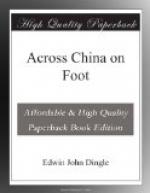Fifty men—coolies who were carrying general merchandise in all directions, and who had taken shelter in the large inn I stayed at—rose with me the next morning. As I ate my morning meal, spluttering the rice over the floor as I tried vainly to control my chopsticks with frost-nipped fingers, they went through the filthy round of early morning routine. Squatting about with their dirty face-rags, and a half-pint of greasy water in their brass receptacle shaped like the soup-plate of civilization, and leaving upon their necks the traces of their swills, they wiped the dirt into their hair, and considered they had washed themselves. Men would emerge from their rooms, fully dressed, with the dishclout in one hand and the hand-basin in the other—on the way to their morning tub. Oh, the filth, the unspeakable filth of these people! Would that the Chinese would emulate the cleanliness of the Japs, though even that I would question. In several years in the Orient I have not yet come across the cleanliness in any race of people to be compared with that cleanliness which in England is next to godliness.
The people of Pu-peng were pleased to see me. They hurried about obligingly to get food for man and beast, and the womankind, poor but light-hearted, cracked suggestive jokes with my men with the utmost freedom.
In this town there are many Lolo—it might be said that the entire population is of Lolo origin, although had I suggested to any particular inhabitant that this was a fact he would probably have taken keen offense, and things might have gone badly with me. With the men it is most difficult to tell—there is little difference between the Han ren and the tribesman. But the difference is often most marked in respect to the women. The Chinese woman has a considerably fairer skin than the female of Lolo descent, and her customs and manners, apart from the distinct colloquial accent, are quite evident as pretty sure proof of distinction of race. After the Lolo have mingled with the Chinese for a few years, however, it is quite difficult to differentiate between them, as most of the Lolo women now speak Chinese (in this town I did not hear any language foreign to the Chinese language), and a good many of the men are sufficiently educated to read the Chinese character even if they do not write it. The forward racial condition of the Lolo people in this district is far greater than that of the people of the same tribe to the west of Tali-fu, and in latitudes where their language and customs of life and dress are more or less maintained. The women are generally of better physique than the Chinese, principally on account of the fact that their work is almost exclusively outdoor; but as they begin to copy the Chinese, and live a more sedentary life, this fine physique will probably gradually disappear. A good many already bind their feet.
When I came out in the early morning the thermometer was twenty degrees below zero, and my nose was red and without feeling. Feng-mao[AQ] and great coat were required, but I was totally oblivious of the hour’s stiff climbing awaiting me immediately outside the town, to reach the highest point in which bathed me in perspiration as if I had played three sets of tennis in the tropics.




